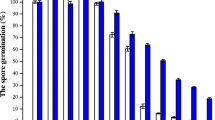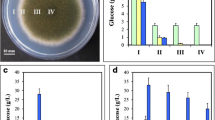Abstract
For citric acid-accumulating Aspergillus niger cells, the enhancement of anaplerotic reactions replenishing tricarboxylic acid cycle intermediates predisposes the cells to form the product. However, there is no increased citrate level in germinating spores and a complex sequence of developmental events is needed to change the metabolism in a way that leads to an increased level of tricarboxylic acid cycle intermediates in mycelia. A review of physiological events that cause such intracellular conditions, with the special emphasis on the discussion of hexose transport into the cells and regulation of primary metabolism, predominantly of glycolytic flux during the process, is presented.



Similar content being viewed by others
References
Arisan-Atac I, Wolschek MF, Kubicek CP (1996) Trehalose 6-phosphate synthase A affects citrate accumulation by Aspergillus niger under conditions of high glycolytic flux. FEMS Microbiol Lett 140:77–83
Arts E, Kubicek CP, Röhr M (1987) Regulation of phosphofructokinase from Aspergillus niger: effect of fructose 2,6-bisphosphate on the action of citrate, ammonium ions and AMP. Microbiology 133:1195–1199
de Graaff L, van den Broeck H, Visser J (1992) Isolation and characterization of the Aspergillus niger pyruvate kinase gene. Curr Genet 22:21–27
d’Enfert C, Bonini BM, Zapella PD et al (1999) Neutral trehalases catalyse intracellular trehalose breakdown in the filamentous fungi Aspergillus nidulans and Neurospora crassa. Mol Microbiol 32:471–483
David H, Akesson M, Nielsen J (2003) Reconstruction of the central carbon metabolism of Aspergillus niger. Eur J Biochem 270:4243–4253
Dumbrava VA, Pall ML (1987) Regulation of fructose 2,6-bisphosphate levels in Neurospora crassa. Biochim Biophys Acta 925:210–217
Fillinger S, Chaveroche MK, van Dijck P et al (2001) Trehalose is required for the acquisition of tolerance to a variety of stresses in the filamentous fungus Aspergillus nidulans. Microbiology 147:1851–1862
Forment JV, Flipphi M, Ramon D et al (2006) Identification of the mstE gene encoding a glucose-inducible, low affinity glucose transporter in Aspergillus nidulans. J Biol Chem 281:8339–8346
Francois J, Van Schaftingen E, Hers HG (1984) The mechanism by which glucose increases fructose 2,6-bisphosphate concentration in Saccharomyces cerevisiae. A cyclic-AMP-dependent activation of phosphofructokinase 2. Eur J Biochem 145:187–193
Galagan JE, Calvo SE, Cuomo C et al (2005) Sequencing of Aspergillus nidulans and comparative analysis with A. fumigatus and A. oryzae. Nature 438:1105–1115
Gradišnik-Grapulin M, Legiša M (1997) A spontaneous change in the intracellular cyclic AMP level in Aspergillus niger is influenced by the sucrose concentration in the medium and by light. Appl Environ Microbiol 63:2844–2849
Habison A, Kubicek CP, Röhr M (1983) Partial purification and regulatory properties of phosphofructokinase from Aspergillus niger. Biochem J 209:669–676
Hesse SJ, Ruijter GJG, Dijkema C et al (2002) Intracellular pH homeostasis in the filamentous fungus Aspergillus niger. Eur J Biochem 269:3485–3494
Hondmann DHA, Visser J (1994) Carbon metabolism. In: Martinelli SD, Kinghorn JR (eds) Aspergillus: 50 years on, progress in industrial microbiology, vol 29. Elsevier, Amsterdam, pp59–139
Jernejc K, Legiša M (2004) A drop of intracellular pH stimulates citric acid accumulation by some strains of Aspergillus niger. J Biotechnol 112:289–297
Karaffa L, Kubicek CP (2003) Aspergillus niger citric acid accumulation: do we understand this well working black box? Appl Microbiol Biotechnol 61:189–196
Kubicek CP, Röhr M (1978) The role of the tricarboxylic acid cycle in citric acid accumulation by Aspergillus niger. Eur J Appl Microbiol Biotechnol 5:263–271
Kubicek-Pranz EM, Mozelt M, Röhr M et al (1990) Changes in the concentration of fructose 2,6-bisphosphate in Aspergillus niger during stimulation of acidogenesis by elevated sucrose concentration. Biochim Biophys Acta 1033:250–255
Legiša M, Benčina M (1994) Evidence for the activation of 6-phosphofructo-1-kinase by cAMP-dependent protein kinase in Aspergillus niger. FEMS Microbiol Lett 118:327–333
Legiša M, Cimerman A, Sterle M (1981) Germination of Aspergillus niger in a high citric acid yielding medium. FEMS Microbiol Lett 11:149–152
Legiša M, Kidrič J (1989) Initiation of citric acid accumulation in the early stages of Aspergillus niger growth. Appl Microbiol Biotechnol 31:453–457
Legiša M, Mattey M (1986a) Glycerol as an initiator of citric acid accumulation in Aspergillus niger. Enzyme Microb Technol 8:258–259
Legiša M, Mattey M (1986b) Glycerol synthesis by Aspergillus niger under citric acid accumulating conditions. Enzyme Microb Technol 8:607–609
Ma H, Kubicek CP, Röhr M (1985) Metabolic effects of manganese deficiency in Aspergillus niger: evidence for increased protein degradation. Arch Microbiol 141:266–268
Machida M, Asai K, Sano M et al (2005) Genome sequencing and analysis of Aspergillus oryzae. Nature 438:1157–1161
Meixner-Monori B, Kubicek CP, Röhr M (1984) Pyruvate kinase from Aspergillus niger: a regulatory enzyme in glycolysis? Can J Microbiol 30:16–22
Mesojednik S, Legiša M (2005) Post-translational modification of 6-phosphofructo-1-kinase in Aspergillus niger. Appl Environ Microbiol 71:1425–1432
Mlakar T, Legiša M (2006) Citrate inhibition resistant from of 6-phosphofructo-1-kinase from Aspergillus niger. Appl Environ Microbiol 72:4515–4521
Nierman WC, Pain A, Anderson MJ et al (2005) Genomic sequence of the pathogenic and allergenic filamentous fungus Aspergillus fumigatus. Nature 438:1151–1156
Panneman H, Ruijter GJG, van den Broeck HC et al (1998) Cloning and biochemical characterisation of Aspergillus niger hexokinase—the enzyme is strongly inhibited by physiological concentrations of trehalose 6-phosphate. Eur J Biochem 258:223–232
Panneman H, Ruijter GJG, van den Broeck HC et al (1996) Cloning and biochemical characterisation of an Aspergillus niger glucokinase. Evidence for the presence of separate glucokinase and hexokinase enzymes. Eur J Biochem 240:518–525
Papagianni M, Wayman F, Mattey M (2005). Fate and role of ammonium ions during fermentation of citric acid by Aspergillus niger. Appl Environ Microbiol 71:7178–7186
Peksel A, Torres NV, Liu J et al (2002) 13C-NMR analysis of glucose metabolism during citric acid production by Aspergillus niger. Appl Microbiol Biotechnol 58:157–163
Poorman RA, Randolph A, Kemp RG et al (1984) Evolution of phosphofructokinase-gene duplication and creation of new effector sites. Nature 309:467–469
Röhr M, Kubicek CP (1981) Regulatory aspects of citric acid fermentation by Aspergillus niger. Process Biochem 16:34–37
Röhr M, Kubicek CP, Zehentgruber O et al (1987) Accumulation and partial re-consumption of polyols during citric acid fermentation by Aspergillus niger. Appl Microbiol Biotechnol 27:235–239
Ruijter GJG, Kubicek CP, Visser J (2002) Production of organic acids by fungi. In: Osiewacz HD (ed) The mycota X industrial applications, Springer-Verlag, Berlin, Heidelberg, New York
Ruijter GJG, Panneman H, Visser J (1997) Overexpression of phosphofructokinase and pyruvate kinase in citric acid-producing Aspergillus niger. Biochim Biophys Acta 1334:317–326
Schreferl G, Kubicek CP, Röhr M (1986) Inhibition of citric acid accumulation by manganese ions in Aspergillus niger mutants with reduced citrate control of phosphofructokinase. J Bacteriol 165:1019–1022
Thevelein JM, de Winde JH (1999) Novel sensing mechanisms and targets for the cAMP-protein kinase. A pathway in the yeast Saccharomyces cerevisiae. Mol Microbiol 33:904–918
Torres NV (1994a) Modelling approach to control of carbohydrate metabolism during citric acid accumulation by Aspergillus niger: I. Model definition and stability of steady state. Biotechnol Bioeng 44:104–111
Torres NV (1994b) Modelling approach to control of carbohydrate metabolism during citric acid accumulation by Aspergillus niger: II. Sensitivity analysis. Biotechnol Bioeng 44:112–118
Torres NV, Voit EO, Gonzalez-Alcon C (1996a) Optimization of nonlinear biotechnological process with linear programming: application to citric acid production by Aspergillus niger. Biotechnol Bioeng 49:247–258
Torres NV, Riol-Cimas JM, Wolschek M et al (1996b) Glucose transport by Aspergillus niger: the low affinity carrier is only formed during growth on high glucose concentrations. Appl Microbiol Biotechnol 44:790–794
van den Hombergh JP, van de Vondervoort PJ, Fraissinet-Tachet L et al (1997) Aspergillus as a host for heterologous protein production: the problem of proteases. Trends Biotechnol 15:256–263
vanKuyk PA, Diderich JA, MacCabe AP et al (2004) Aspergillus niger mstA encodes a high-affinity sugar/H+ symporter which is regulated in response to extracellular pH. Biochem J 379:375–383
Wayman FM, Mattey M (2000) Simple diffusion is the primary mechanism for glucose uptake during the production phase of the Aspergillus niger citric acid process. Biotechnol Bioeng 67:451–456
Wolschek MF, Kubicek CP (1999) Biochemistry of citric acid accumulation by Aspergillus niger. In: Kristiansen B, Mattey M, Linden J (eds) Citric acid biotechnology, Taylor Francis Ltd., London
Wrolstad RE, Shallenberger RS (1981) Free sugars and sorbitol in fruits—a complication from the literature. J Assoc Anal Chem 64:91–103
Author information
Authors and Affiliations
Corresponding author
Rights and permissions
About this article
Cite this article
Legiša, M., Mattey, M. Changes in primary metabolism leading to citric acid overflow in Aspergillus niger . Biotechnol Lett 29, 181–190 (2007). https://doi.org/10.1007/s10529-006-9235-z
Received:
Revised:
Accepted:
Published:
Issue Date:
DOI: https://doi.org/10.1007/s10529-006-9235-z




